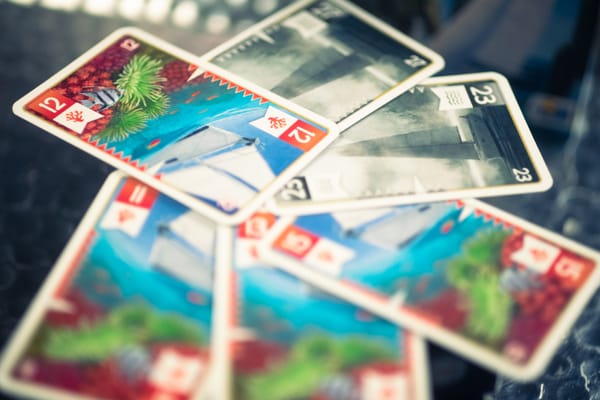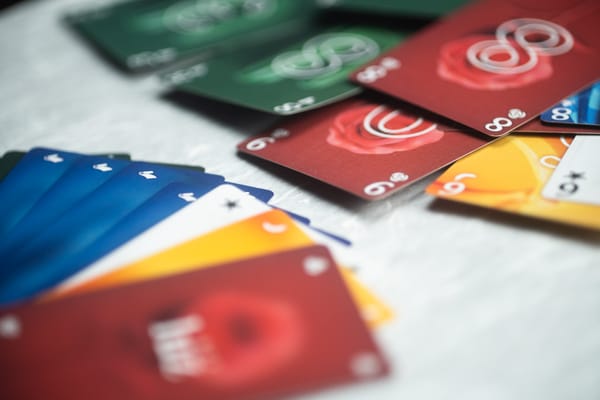My five favorite trick-taking games
This list could change at any moment.
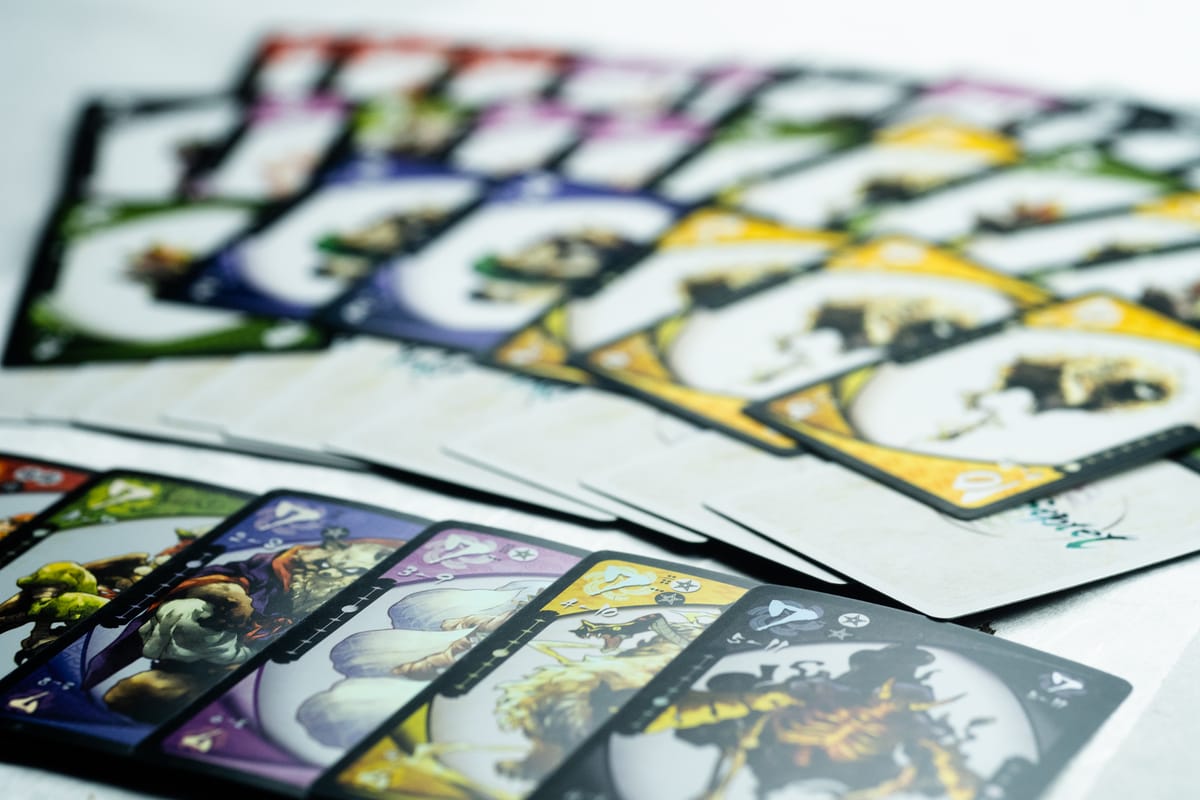
For as much as I’ve talked about trick-taking games in this newsletter, you’d think I’d be better prepared to answer this question. What are my favorite trick-taking games, I wonder? There are so many to choose from — and I’ve played so many over the past few years! — but I’m looking here for games that I’d recommend unreservedly. I’m looking for games that I’d always want to play.
I won’t be doing much in the way of honorable mentions this time. I will, however, tell you that I’ll be breaking this broad topic into some subcategories in the future. (Climbing games? Sure! Japanese trick-takers? Why not! Traditional games? Maybe if I do a lot more research!)
The Crew: The Quest for Planet Nine and The Crew: Mission Deep Sea
I’ve paired these two games together not because they’re the same game, but rather because they sort of exist as two halves of one whole. Both of these games are cooperative mission-driven campaign games, and both thrive with repeated plays. The cooperative campaign in The Crew: The Quest for Planet Nine (Sing, 2019) is one of the most fluid ramping-up experiences I’ve had in a board game. The way my group was able to go from the first few missions to the final mission speaks well to how finely tuned the game is. The Crew: Mission Deep Sea (Sing, 2020) extends the system into something a bit more chaotic. Each time you play a mission, you’re drawing objective cards from a very large pool. Sometimes an early mission might feature two objectives that pair very poorly together. Other times, a late mission might end up with several objectives that go together extremely well.
That’s the duality of The Crew. The first game creates a system that’s exciting to play, and as importantly, exciting in which to make progress. The campaign is, to my estimation, the most important part of this game. There is nothing particularly innovative about the trick play, which follows the standard must-follow architecture established so long ago. There’s one major change about the construction of the deck in the form of one four-card trump suit, and that is a fairly crucial change for gameplay, but it’s not hugely innovative on its own. Instead, what we end up with is a fairly basic trick-play game that adds ramping complexity. In so doing, it creates a game that almost functions as a teaching opportunity for the wide world of trick-taking games. While it’s easy to teach most trick-taking games from a strict rules perspective, it’s more difficult to teach strategy. Intentional off-suiting can take some time for beginning players to understand fully, for example — but in The Crew, it becomes an essential feature, and players must learn it.
The second game, Mission Deep Sea, is a different sort of game. It’s a game with some ramping difficulty, but there are few defined missions that must be accomplished in the course of a campaign. The game is instead about seeing the breadth on offer. It’s about exploring the system at its limits. While this one has the higher rating, I’m inclined to describe it as a slightly hampered experience. The random task selection is more prone to poor experiences and impossible scenarios. That’s not to describe it as a bad game — it’s definitely not. Its rough edges aren’t a true downside for passionate players; they’re more an upside, with more in the game to explore, more difficult scenarios by which you can be challenged. If you love The Quest for Planet Nine, you’re likely to love Mission Deep Sea. It’s more of the same, at least in spirit.
Designed by Thomas Sing, illustrated by Marco Armbruster and published by KOSMOS.
Le Plateau
There is something about Le Plateau (Brown and Gallardo, 2021) that feels old and arcane. Maybe it’s that it’s played with a 78-card French Tarot deck, with more (21!) trump cards than cards in any other single suit. The trick play is very nearly straightforward, with must-follow as the order of the day, but this has the slightly unusual rule that you must play a trump card if you cannot follow a led suit. Few modern games feature this particular rule, but it’s a feature of Tarot trick-taking games, and you’ll see it in Pinochle, too. (I have learned this just now thanks to the wonders of Wikipedia.) Including that feature of Tarot games makes sense, given the deck construction, but it contributes to the feeling that Le Plateau is a lost historical game.
I’ve not even touched on the part of Le Plateau that makes it truly remarkable. This isn’t just a trick-taking game — it’s also an area control game. Play is realized on a hexagonal board on which each space represents either cards won in a trick or the position of the trick in the round. At the beginning of each round, players will be bidding to compete in a bit of an area control game, either with a partner or alone. Bids start at connecting two opposite sides of the board, and they range all the way to connecting each side of the board.
More difficult bids are worth more points, as you’d imagine. Your partner is chosen by calling out a card not in your hand. The must-trump rule can really foil your own plans. All that plays into this game feeling somewhat built for expert trick-taking players. The ruleset doesn’t demand that sort of expertise, but the game’s strategy does — and as a result, I’ve felt like I’ve learned something new every time I’ve played the game. While most trick-taking games don’t bring out my competitive side (few board games do, really), Le Plateau does.
This one makes my favorite list for a few reasons. That it brings out my competitive side is certainly one of those. It rewards clever play and clever bidding, and it also rewards a good partnership. When I play Le Plateau, I’m excited about trick-taking. And, of course, the board — I just can’t get enough of the board.
Designed by Dr. Steven Brown and Raymond Gallardo, illustrated by Raymond Gallardo, and published by BrownCastle Games.
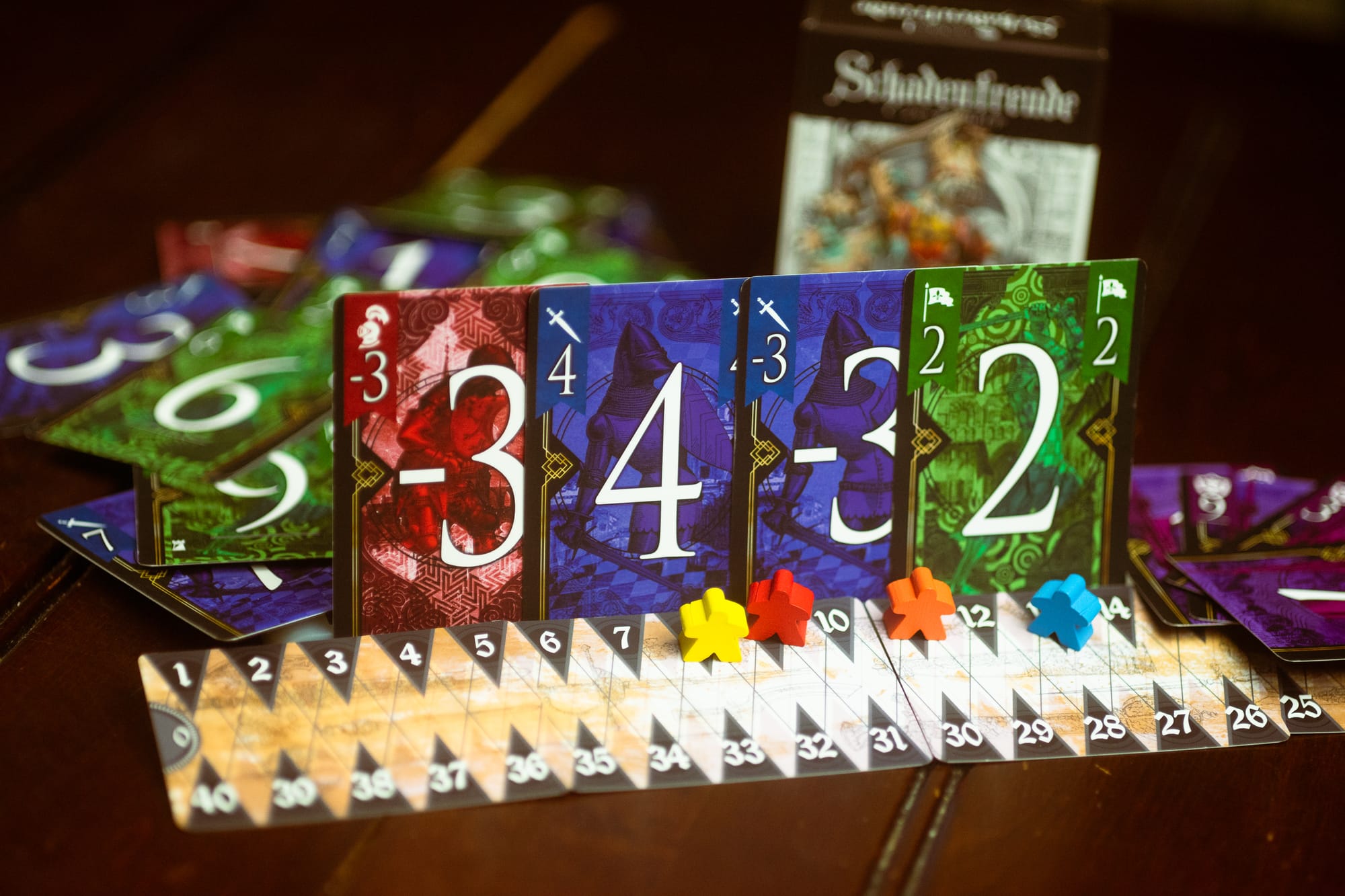
Schadenfreude
When I tell people about the amazing things happening in the Japanese trick-taking scene over the last decade, Schadenfreude (ctr, 2020) is one of the first games I highlight. This is a trick-taking game that compares well against of the great modern trick-takers. It features all the parts we’ve come to expect of a “trick-taking game with a twist,” a term that I’m not sure I like very much but will use here for illustration. (I will say, this includes several important twists — and they’re not particularly twists, but more ways the game uses trick-taking as a scaffold for something delightful.
In Schadenfreude, players aren’t competing to get the most points, nor are they competing to get the least. They’re instead competing to try to push players over a 40-point limit, which triggers the end of the game and makes any player over said limit ineligible for victory. Points are gained through cards won in tricks, which consist of the card played to win the trick and any cards that were played off-suit. When you collect a card of a rank already in your score pile, both are discarded, potentially saving you from disaster or dooming you to mediocrity. At the end of the round, when you’re tallying your points and just hoping you don’t go over 40, and your friend is laughing because they know you did? That’s schadenfreude. And Schadenfreude.
Designed by ctr and published by Studio Turbine.
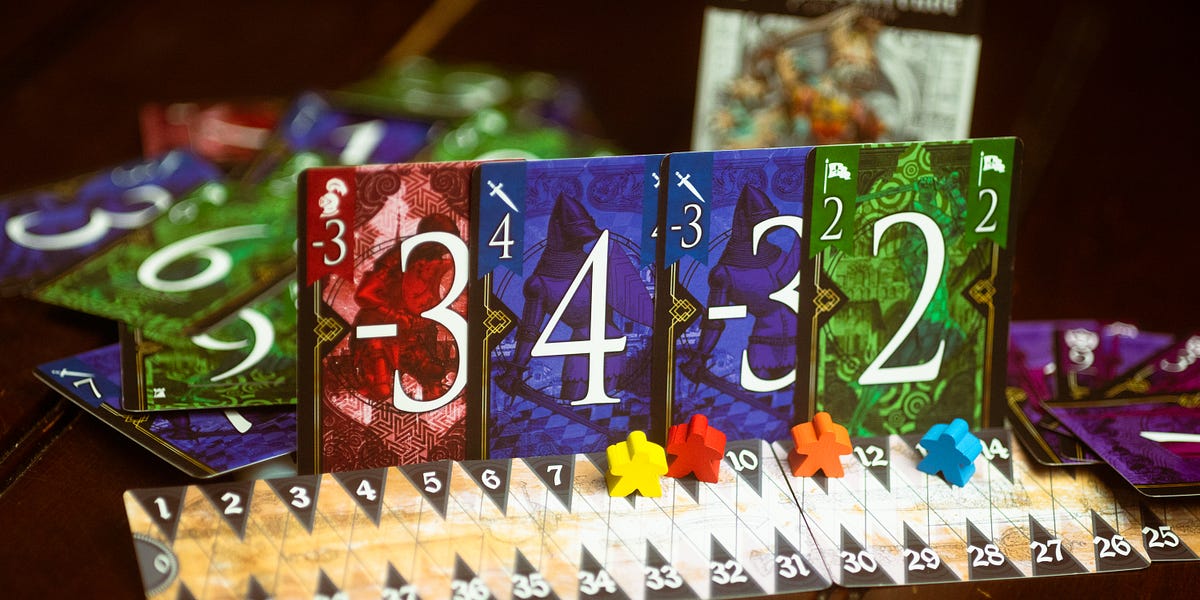

Seas of Strife
When I’m looking for a six-player trick-taking game for a group of mixed gamers, Seas of Strife (Major, 2015) is my go-to. There simply aren’t that many great trick-taking games at that specific player count. Skull King (Beck and Beck, 2013) works, but it’s far too chaotic to make my top five. Rebel Princess (Byrne, Guerrero, Peláez and Virgós, 2023) is an option, but it feels a bit like six players is too many. (Much like I’d say it’s too many players in Hearts.) Even Diamonds (Fitzgerald, 2014) is a reasonable option, or you could look at the entertaining and chaotic Tournament at Camelot (Boginski, Boginski-Barbessi and Shannon, 2017) and its 2020 sequel, Tournament at Avalon. A common theme, though, is that six players just isn’t where these games shine. So many great trick-taking games are designed with four players in mind, and it shows when their limits are pushed.
Seas of Strife is different. At six players, you experience the fullness of the game. In this trick-taker that’s gone through a fascinating publishing history to get to its nautical theme, you have a game that’s built for six. In each trick, one player leads in a suit, and all players must follow that suit — unless a player breaks suit, which gives every subsequent player an opportunity to follow any suit played to the trick. The highest card in the most prominent suit wins the trick, with ties going to the higher card. The makeup of the deck is linear, with sections of cards in a single suit — so orange is 0–10, red is 11-20, and so on and so forth, ending with dark red at 71–74.
With six players, the opportunities for players to off-suit increases significantly. It makes the game’s flow mechanically just that much better, and to do that at six players for a trick-taking perspective without leaning into chaos — that’s what puts Seas of Strife into my top five right now.
Designed by Mark Major, illustrated in the most recent edition by Beth Sobel, and published in the U.S. by Rio Grande Games.

Yokai Septet
Partnership trick-taking is an interesting thing. Take a game like Tichu (Hostettler, 1991), wherein there’s a strong meta, and good players can communicate with their partners by the cards they pass. (Yes, it’s a climbing game. Does that make it a trick-taking game? I think so, at least in many senses. I still don’t know, though. Do you?) Unlike the aforementioned Le Plateau, where partnerships are dynamic, Yokai Septet (Yokouchi, 2018) is a fixed-partnership game.
There are a few interesting things going on here that keep me coming back. First, the makeup of the deck isn’t fully symmetric; there are seven suits with seven cards each, but the ranks vary, with some suits having lower-ranked cards and others having higher-ranked cards. Each suit has a 7-rank card — are you sensing a theme around sevens? The whole of the game has teams (or, in the three-player version, individuals) competing to win the majority of the 7s in the game. And that’s all fine and good, but there’s more: If a team wins seven tricks without winning four of 7s (the Boss Yokai), they lose.
All of that melds together (ha) to make a fascinating little trick-taking game. The several moving parts all work together harmoniously, and that’s a real feat of game design.
Designed by Muneyuki Yokouchi, illustrated by Sylvain Leroy, and published by Ninja Star Games.
A few caveats, of course. First, I reserve the right to change this list in my head at any given moment. There’s just no helping that. Second, there are so many games I’d love to put on here, but I haven’t, for one reason or another. Really, this was just dreadfully hard to choose.
Anyway! Thanks for joining me at Don’t Eat the Meeples this week. My next newsletter will be my annual gift guide — I can’t believe the holiday season is upon us, but I also can’t believe a new baby is upon us (us being my family, to be specific. Not you and me. Sorry!) I’m not sure when exactly that’ll be going out, but I’m hoping for next Wednesday. It could be early December, though. Time will tell!



